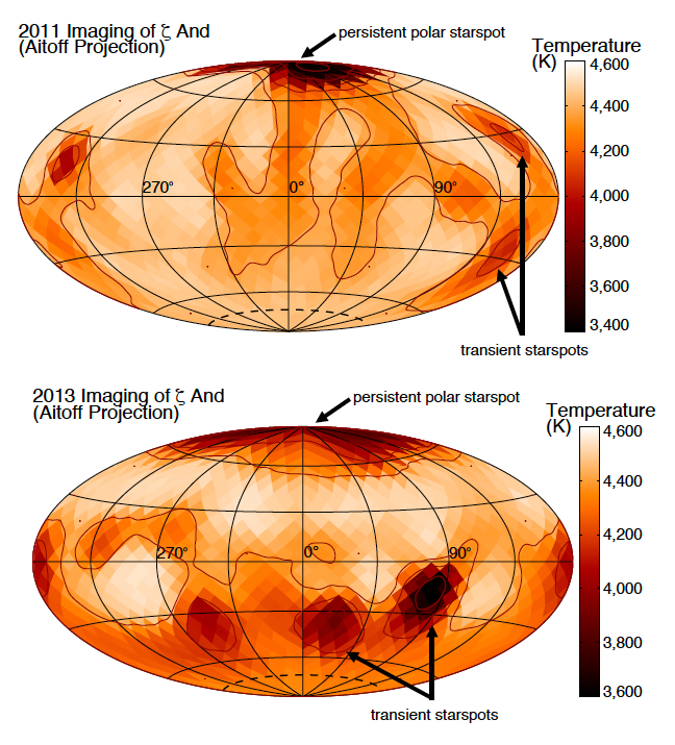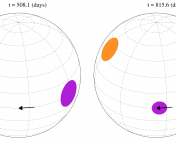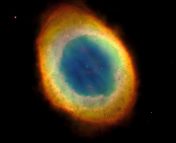Title: No Sun-like dynamo on the active star ζ Andromedae from starspot asymmetry
Authors: R. M. Roettenbacher, J. D. Monnier, H. Korhonen, A. N. Aarnio, F. Baron, X. Che, R. O. Harmon, Zs. Kővári, S. Kraus, G. H. Schaefer, G. Torres, M. Zhao, T. A. ten Brummelaar, J. Sturmann, & L. Sturmann
First Author’s Institution: Department of Astronomy, University of Michigan, Ann Arbor, Michigan
Status: Published in Nature [closed access]
What’s a starspot anyway?
Starspots, also called sunspots when they appear on the Sun, are one of the many curious characteristics that stars possess. They appear as dark patches on the photosphere, or outer shell, of a star. In reality, they are areas of reduced surface temperature, caused by the magnetic field inhibiting the process of convection, or the transfer of heat due to the movement of plasma within a star. These starspots can have a powerful impact on stellar properties.
The suppressed convection that causes starspots can also puff up the star, decreasing temperature and brightness, which can inhibit astronomers’ ability to measure stellar masses and ages. Observing and characterizing starspots is also important to exoplanet studies, as starspots can provoke false planet detections or lead to erroneous planetary properties for transiting exoplanets (check out this astrobite for more information about how starspots affect the search for planets around other stars).
Spotting the Spots
Until recently, astronomers have relied on Doppler imaging to study the surface structure of stars other than the Sun. Stellar surface structures, such as starspots, create distortions in the spectral lines of stars due to the Doppler effect, or the difference in frequency between a wave leaving a moving source and reaching an observer. However, Doppler imaging cannot distinguish the hemisphere in which the starspot is located. Furthermore, Doppler imaging can easily produce artifacts that look like starspots on the northern or southern pole of a star, also called polar spots. Thus, the reliability of polar spots has been highly debated.
The authors of this paper therefore set out to study starspots with a different technique instead: long-baseline interferometry. The authors imaged the star ζ Andromedae (ζ And) to try to ‘see’ its starspots with this technique. Long-baseline interferometry utilizes multiple telescopes at certain distances, or baselines, away from one another. The observations from these telescopes can then be combined to emulate a telescope with a diameter equal to the maximum separation between the telescopes. However, since photons are only collected by the smaller telescopes within the array, long-baseline interferometry is limited to observing large, bright stars that emit a huge number of photons.
To observe ζ And, the authors utilized the Michigan InfraRed Combiner (MIRC) with all six telescopes at Georgia State University’s Center for High Angular Resolution Astronomy (CHARA) array on Mount Wilson in California. ζ And is a large active star with many starspots, making it a good candidate for interferometric studies. It resides within a tidally-locked close binary system, which has caused strong starspots and magnetic activity to develop on ζ And.
Making a Map of ζ And
The researchers’ resulting interferometric images of ζ And clarified the exact hemispheres of the starspots, and demonstrated asymmetries between the hemispheres. On the Sun, starspots are typically seen on both hemispheres. This break in the symmetry of the starspots indicates that ζ And has a more complicated dynamo, or physical process that generates a magnetic field, than the Sun.
The authors also confirmed the existence of polar spots. Figure 1 demonstrates the ‘map’ of ζ And’s surface that the researchers created with their interferometric images. While the starspots closer to the equator are transient, the spots on the north pole are persistent in observations spanning two years. This observation is highly significant because it is the first independent confirmation of polar spots.

These results indicate that global magnetic structures cover the faces of the most active stars. Interferometric imaging is able to reveal explicit signs of these structures. In the future, combining long-baseline interferometry with Doppler imaging could eliminate ambiguity in the location of a starspot for stars whose surfaces cannot be spatially resolved. This would allow for more accurate surface maps of stars and improved stellar dynamo models to be developed, as well as an understanding of how a changing magnetic field can affect our observations of stellar mass and age. These results bring us one step closer to unlocking the mysteries of magnetic fields, both close to home on the Sun and on stars far away like the spotted ζ And.
Astrobite edited by Zili Shen and Charles Law
Featured image credit: Roettenbacher et al.




